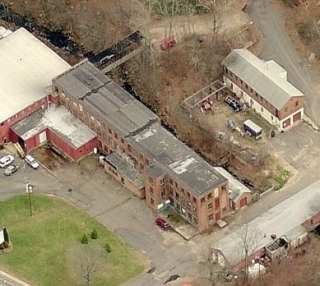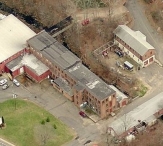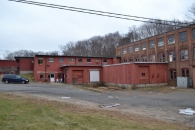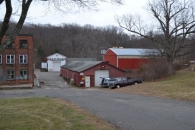Mill Record East Hampton
RETURN TO ‘FIND MILLS’Disclaimer: Content for these properties was compiled in 2014-2017 from a variety of sources and is subject to change. Updates are occasionally made under Property Information, however the Connecticut Trust for Historic Preservation (dba Preservation Connecticut) makes no representation or warranty that the information is complete or up-to-date.
- Complex Name (Common)
- N.N. Hill Brass Co.
- Complex Name (Historic)
-
- N.N. Hill Brass Co.
- Address or Location
- 25 Skinner Street, East Hampton
- County
- Middlesex
- Historic Designation
- Associated Mill Community
- n/a
 What can you do at this mill?
What can you do at this mill?
- Historic Information
Companies Associated w/Complex
- N.N. Hill Brass Co. ca. 1890-1960
Use (Historic)
Largest Documented Workforce
125 (1902)
Historic Narrative
Known as “Belltown U.S.A.”, East Hampton was dominated by bell manufacturers for much of its history. This began with the arrival of William Barton in 1808 and continued throughout the 19th and early 20th centuries as workers trained in Barton’s mill established their own shops, many of these located along Pocotopaug Creek in the center of town. The organization of the N.N. Hill Brass Company was typical of this experience, as its founder, Norman Newton Hill, had worked in a number of East Hampton’s bell manufactories before establishing his own firm in 1889. Norman N. Hill was born in East Hampton on October 4, 1863. After laboring in the bell mills of his native town as a young man, he initiated activities associated with his own bell manufactory within a barn located on the property of his parent’s home, this located on Skinner Street. After several months Hill moved production into a wooden factory along Pocotopaug Creek. This plant burned down in July 1890 and Hill subsequently constructed a brick mill further upstream. This would house the N.N. Hill Brass Company from ca. 1890 until 1960. The success of the N.N. Hill Brass Company was largely based upon Hill’s innovation of a process for stamping bells from sheet metal, as opposed to standard casting methods, a development that revolutionized the industry. Furthermore, between 1901 and 1902 he developed the Sterling Continuous Ringing Chimes, which was the precursor to the thumb operated handlebar bell found on bicycles throughout the 20th century. Hill developed this product into a line of over 100 styles of bicycle bells, in addition to producing more conventional lines of sleigh, hand, door, tea, and call bells, as well as bells for toys, rattles, and electric bells and gongs. A Hartford Courant article from 1902 noted that, “The factory is one of the largest and best equipped in the state for the manufacture of small bells… The bells are sold all over the world and have a fine reputation for excellence of castings, finish of workmanship, clearness and resonance of tone.” Over 125 hands were employed at the plant at the time in which the aforementioned article was published. This likely increased around 1910, when a three-story, 100’ x 41’ addition was constructed on the north side of the existing plant. The expansion supplemented the existing foundry and two manufacturing blocks, which were powered by a water-driven turbine generator through the 1910s. Hill died on February 18, 1950, however the N.N. Hill Brass Company continued to occupy its Skinner Street plant until 1960. At this point the plant was sold to the Belltown Industrial Corporation, a subsidiary firm that leased the buildings to a variety of light industrial tenants including the Parva Buckle Company of Hamden, Connecticut. Today the complex is owned by Epoch Arts, Inc., an arts-focused non-profit.
- Architectural Information
Number of Existing Buildings
Six (6) blocks.
Dates of Construction
ca. 1890, ca. 1910, ca. 1940
Architect
n/a
Builder
n/a
Building Type
Architectural Description
The former N.N. Hill Brass Company plant is comprised of a complex of four primary buildings and various additional support structures, these located at the northeast corner of the intersection of Skinner and Niles Streets. The factory’s two earliest blocks were erected ca. 1890. These consist of a three-story red brick manufacturing building and a one-story red brick foundry. The manufacturing block measures 100’ x 35’ and is of brick pier construction. It has a 12-bay façade, segmental-arched window openings (some of these later infilled with brick in order to accommodate rectangular steel sash), granite sills, a corbelled cornice, metal coping, and a flat roof. The building’s façade is dominated by a three-story stair tower, this centered on the [west] elevation. The stair tower was originally topped by a cupola with pyramidal roof, however, this was removed by the late 1970s. The manufacturing building was expanded circa 1910 through the addition of a three-story block on its north elevation. This is of similar detailing to the original block, however, its windows are set in rectangular openings and have concrete sills. Most retain their original steel sash with hopper style openings. A one-story, concrete block addition was constructed on the north side of the circa 1910 block around 1940. This measures roughly 80’ x 118’ and has a flat roof. A one-story red brick block located adjacent to the building’s southeast corner is an original feature of the plant, this formerly housing a boiler plant. The final primary building associated with the former N.N. Hill Brass Company factory is the foundry, which is located roughly 25’ southwest of the manufacturing building. The one-story, red brick block measures 128’ x 30’ and has aluminum siding, infilled window openings, and a front-facing gable roof. A roll-up garage-style door is centered on its façade, this flanked on its northern side by a pass-through door. The roof was originally topped by a clerestory monitor, however, this was removed around 1980.
Exterior Material(s)
Structural System(s)
Roof Form
Roof Material
Power Source
Condition
Fair, Deteriorated
Condition Notes
The complex is in generally fair condition, however, some of the exterior walls, windows, and roofs show early signs of deterioration or have been replaced with modern materials.
- Property Information
-
Specific Location
One legal parcel (25 Skinner Street) totaling 1.85 acres at the southeast corner of the intersection of Skinner and Niles Streets
Located in the Belltown Historic District.Adjacent To
Exterior Visible from Public Road?
Yes
Parcel ID / Assessor Record Link
- 02A/ 49/ 1/ 3 / Link →
Acreage
1.85
Use (Present)
- Sources
-
Form Completed By
Lucas A. Karmazinas
Date
12/8/2014
Bibliography
- List of Connecticut Manufacturers, 1922, 1924, 1930, 1932.
- Directory of Connecticut State Manufacturers, 1936, 1939.
- Atlas of Middlesex County, F.W. Beers & Co., 1874.
- Industrial Directory of Connecticut, 1947.
- Register of War Production Facilities in Connecticut, 1951.
- Sanborn Map Company, 1903, 1908, 1914, 1925, 1936.
- Aerial Survey of Connecticut, 1934, 1965.
- The Hartford Courant, 1902, 1950, 1960.
- The History and Architecture of East Hampton, 1980.
- Long Ago, Not Far Away: An Illustrated History of Six Middlesex Country Towns, 1996.
- Roth, Matthew, et al, Connecticut: An Inventory of Historic Engineering and Industrial Sites (Washington DC: SIA, 1981).
- Cunningham, Jan. 1985. Belltown Historic District National Register Nomination No. 85003543. National Park Service.
- Representative View(s)Click on image to view full file







